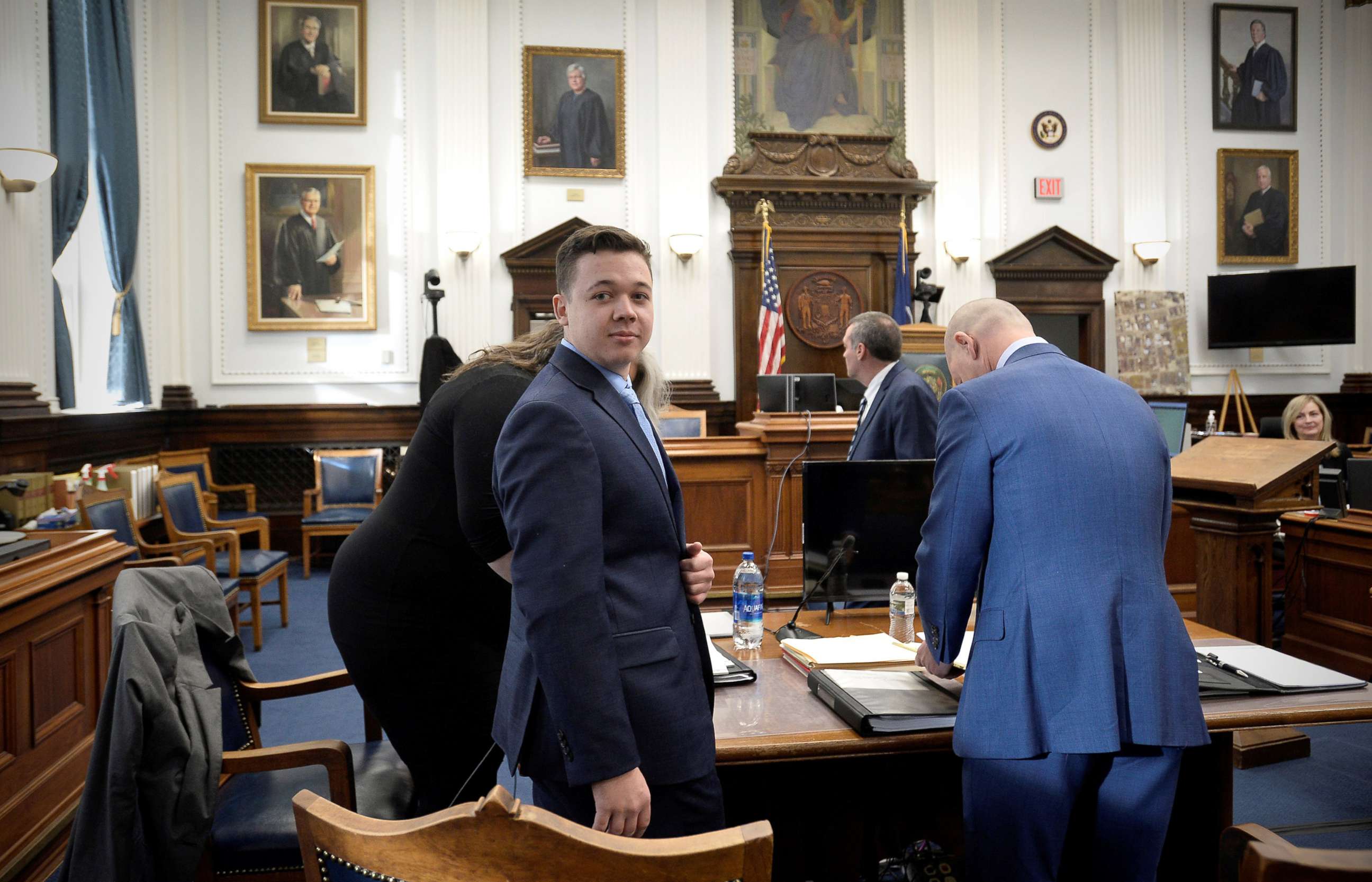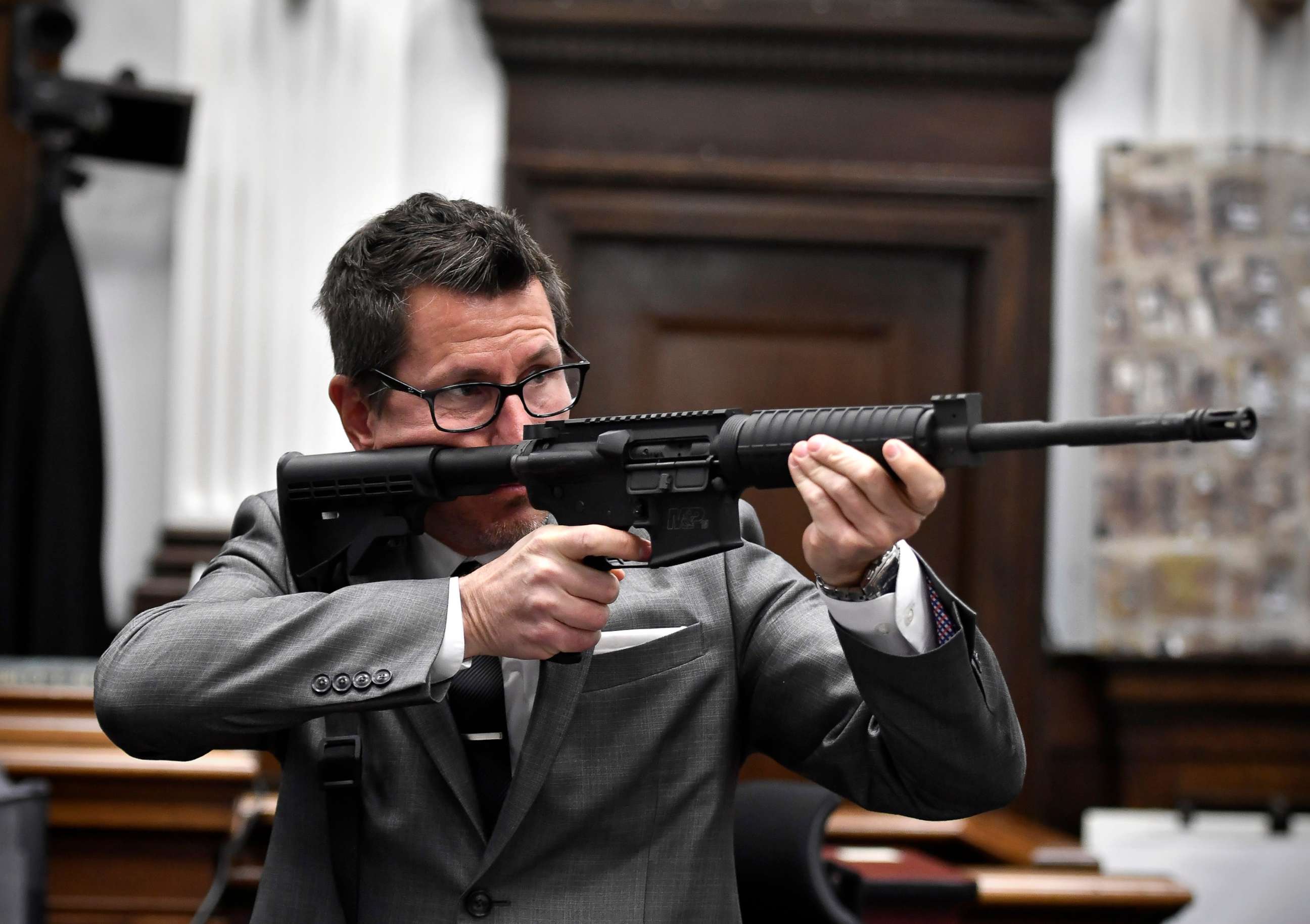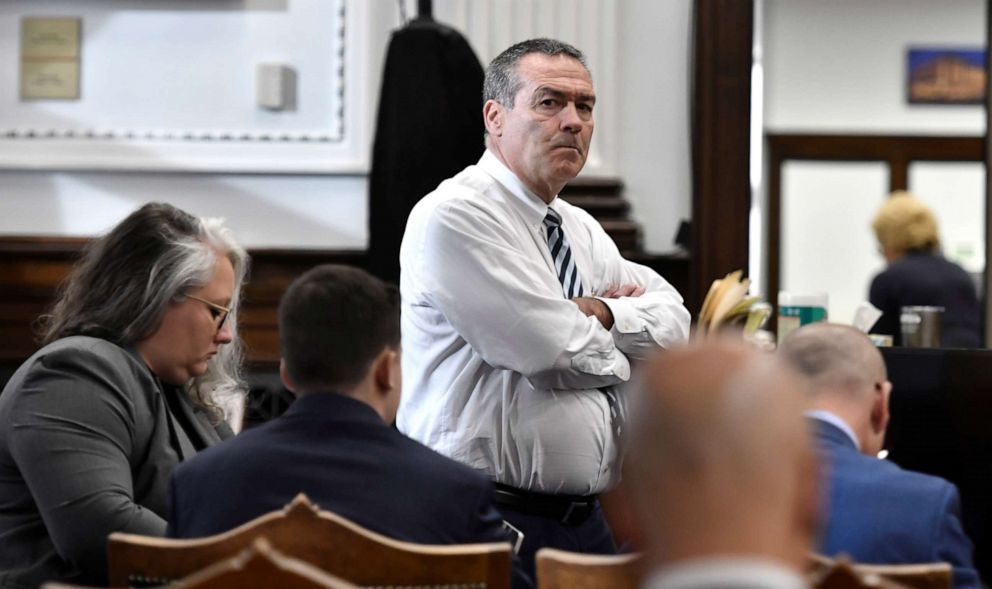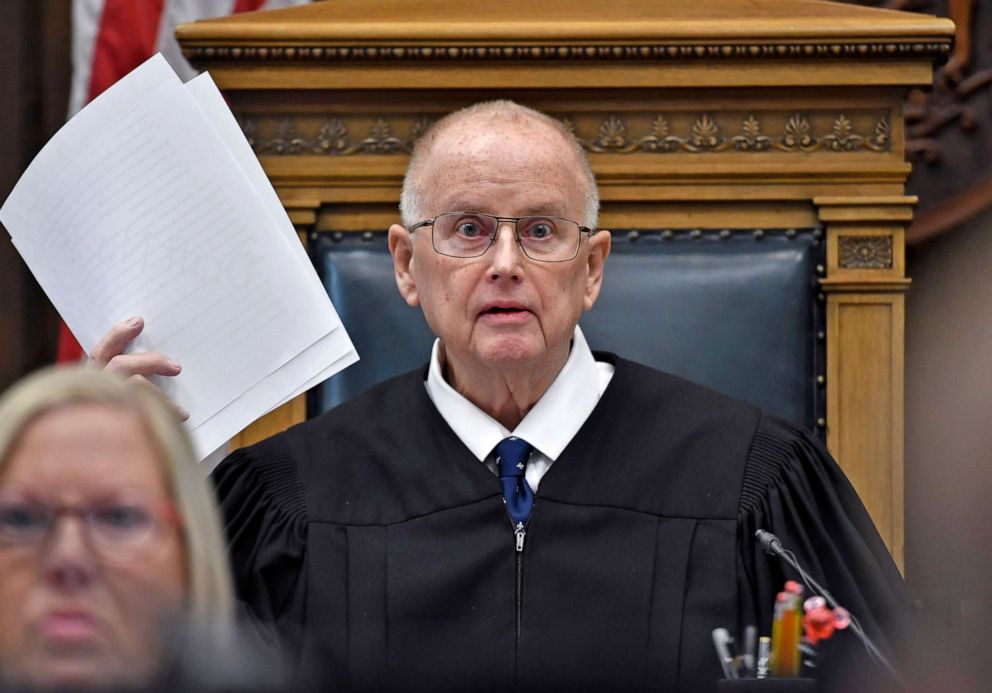Kyle Rittenhouse trial Day 10 ends with closing arguments: Key takeaways
Rittenhouse testified that he shot three men, killing two, in self-defense.
A Wisconsin jury will begin deliberating the fate of Kyle Rittenhouse on Tuesday after hearing starkly different theories of the same evidence, with a prosecutor portraying the teenager as a trouble-seeking active shooter to counter defense claims he shot three men, two fatally, in self-defense.
The Kenosha County Circuit Court jury was sent home for the night after hearing hours of closing arguments in the high-profile homicide trial and getting more than 30 pages of instructions from Judge Bruce Schroeder.
Schroeder told the jury they will begin their deliberations Tuesday after 12 of the 18 panelists who heard evidence in the case are randomly selected to decide Rittenhouse's fate.
Rittenhouse was 17 and armed with an AR-15-style semiautomatic rifle that had a 30-round ammunition clip at the time he shot and killed Joseph Rosenbaum, 36, and Anthony Huber, 26, and severely wounded Gaige Grosskreutz, 27, during an Aug. 25, 2020, protest in Kenosha.

During the trial, which began Nov. 2, Rittenhouse testified that he shot all three men in self-defense as they and others allegedly attacked him during the demonstration over the police shooting of Jacob Blake, a 29-year-old Black man who was left paralyzed.
Rittenhouse, now 18, has pleaded not guilty to charges of first-degree reckless homicide, first-degree intentional homicide, attempted first-degree intentional homicide and two counts of first-degree recklessly endangering safety.
The prosecution's closing argument
Immediately following the jury instructions, prosecutor Thomas Binger began giving his summation by telling the jury, "This is a case in which a 17-year-old teenager killed two unarmed men and severely wounded a third person with an AR-15 that did not belong to him."
"This isn't a situation where he was protecting his home or his family," Binger said. "He killed people after traveling here from Antioch, Illinois, and staying out after a citywide curfew."
Binger launched into detail about the first killing on the night of Aug. 25, 2020, in Kenosha, showing the jury video the prosecutor claims shows that Rittenhouse provoked the deadly encounter with Rosenbaum.
Binger said Rittenhouse sat down a fire extinguisher he had in his left hand and pointed his gun at Rosenbaum and others. In a dramatic reenactment, Binger sat down a water bottle as if it were the fire extinguisher with his left hand and raised the semiautomatic rifle used in the shootings at the courtroom gallery.
"That is what provokes this entire incident. And one of the things to keep in mind is that when the defendant provokes the incident, he loses the right to self-defense," Binger said. "You cannot claim self-defense against a danger you create. That's critical right here. If you're the one who is threatening others, you lose the right to claim self-defense."

The prosecutor asked the jury to watch the video of the Rosenbaum shooting closely, pointing out that Rosenbaum held up his hands as he ran after Rittenhouse and cited the teenager's testimony that he knew the man was unarmed.
"Mr. Rosenbaum is not even within arm's reach when the first shot occurs," Binger said, playing the video of the shooting several times.
Binger described the confrontation between Rosenbaum and Rittenhouse as being akin to a "bar fight," even showing the jurors an image of Patrick Swayze in the movie "Roadhouse," in which the actor played a bar bouncer who protects a small town from a corrupt businessman.
"This is a fight that maybe many of you have been involved in," Binger said, referring to the confrontation between Rittenhouse and Rosenbaum. "Two people, hand to hand. We're throwing punches, we're pushing, we're shoving, we're whatever. But what you don't do is you don't bring a gun to a fistfight."
Binger said that after shooting Rosenbaum, Rittenhouse ran away without attempting to provide first aid. The prosecutor said others in the crowd had every reason to chase after Rittenhouse to stop him.
"At that point, the crowd is dealing with what they perceive to be an active shooter, someone who has just shot someone who is still in possession of the gun, who is fleeing the scene, and how are we supposed to know where he's going next?" Binger said.
He said those chasing Rittenhouse took the "least intrusive means possible" to stop the gunman.
Binger showed video of Rittenhouse running down a street and Huber hitting him twice with a skateboard, the second time after which he said Rittenhouse lost his balance on his own and fell to the ground.
The prosecutor said Rittenhouse without regard for others standing nearby fired twice at an unarmed unidentified man who reportedly kicked him in the face before he fatally shot Huber point-blank in the chest.

Binger said Grosskreutz, who was armed with a pistol, was shot in the right bicep when he tried to disarm Rittenhouse. "Gaige Grosskreutz had his own gun in his own hand. He could have aimed and fired at the defendant, but he did not," Binger said.
He said that despite lying to people throughout the night that he was a trained EMT, Rittenhouse never attempted to help the people he shot.
"This is someone who has no remorse, no regard for life, only cares about himself," the prosecutor said of Rittenhouse.
Binger wrapped up his argument by telling the jury to put themselves in Rittenhouse's shoes and asking if a "reasonable person" would react in the same way.
"I submit to you that no reasonable person would have done what the defendant did. And that makes your decision easy," Binger said. "He's guilty of all counts."
Defense presents argument
Rittenhouse's attorney, Mark Richards, started his closing argument by accusing the prosecution of lying and misrepresenting evidence in a case that he described as a "rush to judgment." He said Rittenhouse was arrested and hit with homicide charges within 48 hours of the shooting while investigators were still interviewing witnesses and collecting evidence.
"Ladies and gentlemen, this case is not a game. It is my client's life," Richards said. "We don't play fast and loose with the facts, pretending that Mr. Rosenbaum was citizen A, No. 1 guy. He was a bad man. He was there. He was causing trouble. He was a rioter. And my client had to deal with him that night alone."

Richards slammed Binger for coming up with the theory of Rittenhouse provoking the initial shooting by allegedly pointing his gun at Rosenbaum and others, saying the prosecutor came up with that "when his case exploded in his face."
He cited video showing Rittenhouse running away from Rosenbaum after he claimed Rosenbaum ambushed him, threw a bag at him and continued to charge after him when the teenager aimed his gun at him. Richards cited the evidence of prosecution witnesses who testified that Rosenbaum, who he said was off his medication for mental illness, had threatened to kill Rittenhouse and others if he ever got them alone, statements Binger said are not found on video and contended never happened.
"Ladies and gentlemen, when my client shot Joseph Rosenbaum, he feared for his life," Richards said. "He feared because of the prior threats, the prior statements and the violent acts that had been witnessed by my client."
Richards added, "Kyle shot Joseph Rosenbaum to stop a threat to his person. And I'm glad he shot him, because if Joseph Rosenbaum had gotten that gun, I don't for a minute believe he wouldn't have used it against somebody else. He was irrational and crazy."
Richards scoffed at Binger's description of Rittenhouse as an "active shooter."
"Kyle was not an active shooter. That is a buzzword that the state wants to latch onto because it excuses the actions of that mob on the 25th of (August) 2020," Richards said.
He said that after shooting Rosenbaum, Rittenhouse was doing the reasonable thing by running to tell the police what had happened only to be kicked in the face by one man and attacked with a skateboard by Huber.
Richards said Grosskreutz was shot because he was coming after Rittenhouse with a handgun and was "going to shoot my client."
"Unfortunately, my client shot him first. If he (Grosskreutz) had retreated, it's over," Richards said.
Richards told the jury that Rittenhouse was under no obligation to testify, yet he did because he wanted the "jurors to hear his personal experience on the night" of the shootings.
"He knew Mr. Binger would cross-examine him for hours, and he was willing to get up on that witness stand, take the oath and tell his story the best way he could," Richards said. "And he did."
Richards described the case against Rittenhouse as a "political case."
"We can take politics out of it as in Democrat and Republican, but the district attorney's office is marching forward with this case because they need somebody to be responsible, they need somebody to put (forth) and say we did it, he's the person who brought terror to Kenosha," Richards said. "Kyle Rittenhouse is not that individual."
Prosecution's rebuttal argument
Prosecutor James Kraus began his rebuttal argument to the defense by countering Richards' statement that Rosenbaum was a serious threat to Rittenhouse.
"It cannot be reasonable for someone to be holding an AR-15 semiautomatic rifle with powerful ammunition and be chased by someone who is unarmed, who is smaller than him, who is shorter than him, and the first thing that you do to defend yourself is you plug four rounds into him," Kraus told the jury.
He said the first of four shots immobilized Rosenbaum by shattering his hip and that the wounded man crumpled to the pavement.
"No one is saying that Mr. Rosenbaum should have chased Mr. Rittenhouse. No one is saying that Mr. Rittenhouse did not have a right to defend himself," Kraus said. "This case is about the right to use deadly force."
He said there was no evidence presented that the unarmed Rosenbaum was capable of killing Rittenhouse with his bare hands.
"Mr. Rittenhouse has size on him. We heard about how he's a swimmer, we heard that he's a lifeguard, he's apparently in some kind of shape. Punch him (Rosenbaum) in the face, kick him in the testicles, knee him in the face, hit him with your gun," Kraus said.
"You don't just immediately get to shoot someone. It is not reasonable for any adult, for any person, for any 17-year-old male to not try and defend yourself first using other methods," he continued. "Why do you have to keep tracking him and shooting him and ending up with a kill shot in the back?"

Prior to closing arguments, Schroeder instructed the jury that they will be allowed to consider lesser charges against Rittenhouse if the panel decides the prosecution failed to meet its burden to prove the original charges.
The judge also granted a defense motion on Monday to dismiss a charge of possession of a dangerous weapon by a person under 18 after the prosecution agreed that the rifle Rittenhouse used in the shooting did not meet the required standard of a short-barreled rifle under the law.



